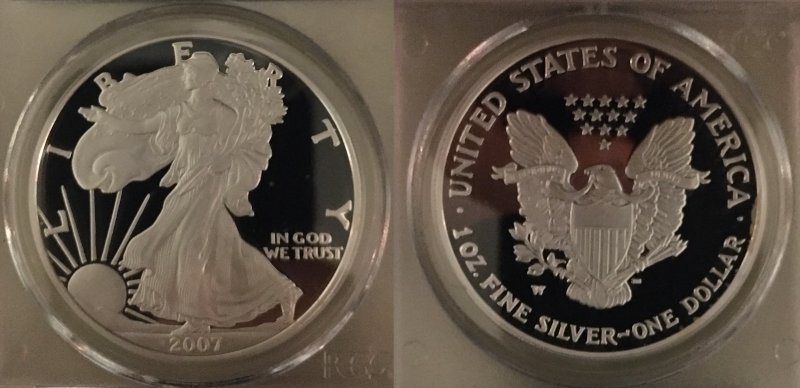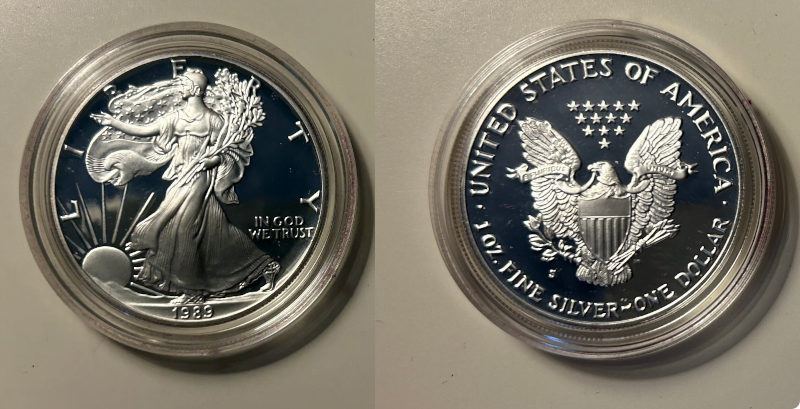One thing I’ve learned since I started writing about numismatics is that federal politicians have a tremendous amount of sway and power when it comes to creating and authorizing the production of coins.
Case in point: U.S. Senator Jim McClure (R-ID).
McClure was the main figure behind the Silver Eagle program – one of the most popular and profitable coin offerings from the U.S. Mint.
It’s not hard to see why they’re so appealing. For one, they’re stable and hold their value well, making them a good investment and a go-to for hedge funders, doomsday apocalyptics, and precious metal hoarders.
For another, they look beautiful. Borrowing from the Walking Liberty half dollar, one of the most acclaimed and beloved designs in American numismatic history, Silver Eagles have been highly sought after by collectors since their inception in 1986. Widely available and fairly affordable, Silver Eagles are a good “gateway coin” for novice and intermediate coin collectors. Indeed, some of the first coins I bought when I started collecting many years ago were Silver Eagles that I saw at a flea market. I was drawn to them because 1) they looked cool, and 2) I wanted to buy silver dollars and Silver Eagles were more valuable than Eisenhower or Anthony dollars and more affordable than Morgan, Trade or Peace dollars.

The genesis for the Silver Eagle program came out of a good old-fashioned dispute between the Department of Defense and the state of Idaho. When the Reagan Administration tried to sell off its excess silver in the early 80s, mining interests cried foul and worried it would depress the market. McClure, who had been elected to the Senate in 1973 and was chairman of the Committee on Energy and Natural Resources, a powerful and influential perch given his state’s silver mines, objected. Together with the rest of Idaho’s congressional delegation, including Senate colleague Steve Symms and Representative Larry Craig, McClure succeeded in delaying the sale indefinitely.
In the meantime, McClure came up with an alternate plan to sell off the silver. Rather than simply auction it off, what if the Mint used the silver to mint special coins and sell them to the general public at a premium? After several failed attempts to pass a bill authorizing the new silver coin, McClure finally succeed in 1985. McClure’s Liberty Coin Act was an amendment to a bill authorizing the minting of a commemorative coin honoring the Statue of Liberty and Ellis Island. The amendment authorized the Treasury to design a $1 coin made of 1 troy ounce of 0.999 fine silver with the image of Lady Liberty on the obverse and an eagle on the reverse.
Bullion coins have been a source of revenue for other countries for some time now. Canada, South Africa, and Mexico, as well as others, sell millions of ounces of gold and silver bullion to U.S. investors each year. It is time for the United States to provide bullion coins minted by the U.S. Mint to the American public… [A] coinage program would not only work but would bring more money into the Treasury than dumping the silver on the market. We have tried, unsuccessfully, the auction method of disposing of stockpile silver. Now I believe we should try the coin method.
Senator James McClure, Congressional Record, June 21, 1985
Senator Frank Murkowski (R-AK) echoed these concerns, pointing out that the Silver Eagle program would appeal to regular people the way that other Mint offerings hadn’t been able to.
For years, Americans have purchased South African Krugerrands, Canadian Maple Leafs, and Mexican bullion coins. They could not buy an American-made U.S. bullion coin if they wanted to, because such coins have simply not been made. The only American coins containing precious metal available in recent years have been commemorative coins, which appeal to a different market element than do bullion coins.
Senator Frank Murkowski, Congressional Record, June 21, 1985

The Silver Eagle program has been so successful that the Mint has even started experimenting with different finishes. To commemorate the 20th anniversary of the program, the Mint released special “reverse proof” Eagles in 2006. The reverse proof coin, essentially, serves as a mirror image to the typical proof coin. Rather than employ a frosty finish on the images and mirror finish on the rest of the coin as with typical proof coins, the reverse proof frosts the field and uses the mirror finish on the images. The contrast can be quite striking and beautiful. Indeed, when I first learned about reverse proofs, I rolled my eyes, thinking that it was yet another cash grab from the Mint. Then I took a look at one of these coins and had to have one.

Speaking of having to have something, here’s a deep cameo finish on a 2007-W Eagle. As I’ve mentioned, I’m a sucker for deep cameo coins, so buying this coin was a no-brainer for me. The finish is quite eye-catching and makes an already gorgeous coin even more stunning.
Meanwhile, private mints have caught on and started providing their own finishes. I’d skip the colored Eagles, holographic Eagles, black ruthenium Eagles, or black ruthenium/gold finish Eagles (I’m from Pittsburgh and love all things black and gold, but even I won’t buy this coin). For one thing, Silver Eagles lose some of their value when they’ve been altered making them more difficult to sell or unload. For another, they just look ugly and tacky. It’s like colorizing classic black-and-white movies. Or looking at challenge coins and deciding that all coins should be like that.
Plus, it’s not like the Mint is running out of ways to freshen up the Silver Eagle. In 2021, they’ll unveil new reverse designs for both Silver and Gold Eagles that will employ the latest in anti-counterfeiting technology. Not sure what that will entail, but as long as it doesn’t look like this, then they’ll have my money.

